I tried traveling all of the Nankai Electric Railway lines with a one-day free pass to celebrate the release of 'Inside Out 2'

Nankai Electric Railway offers a variety of discount tickets, such as the '
In addition, a one-day pass that can be used on all Nankai Railway lines except Kansai Airport Station, Koyasan Station, and Semboku Rapid Railway is on sale for a limited time to commemorate the release of the movie 'Inside Out 2'. Since I had the chance, I decided to try riding all the Nankai Railway lines while also participating in the quiz rally that was being held at the same time.
The article does not show the questions and answers for the quiz rally, but it does show the locations of the panels, so be careful if you want to find where they are yourself.
~To celebrate the release of Disney & Pixar's latest film 'Inside Out 2'~ A tie-up quiz rally will be held from August 1st and one-day free tickets will be on sale | Nankai Electric Railway
https://www.nankai.co.jp/news/240719.html
'Inside Out 2' Release Commemoration 1-Day Free Pass | Nankai Electric Railway
https://www.nankai.co.jp/traffic/otoku/insidehead2.html
We arrived at the starting point, Nankai Namba Station. The ticket gates are on the second and third floors, but since we need to buy our tickets at the counter this time, we head to the second floor.
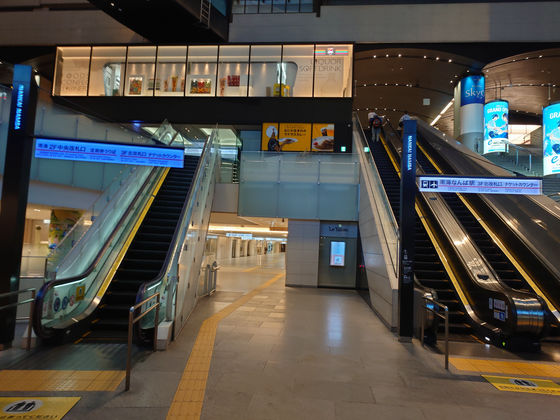
Purchase the 'Inside Out 2' release commemorative 1-day free pass at the service center located at the central ticket gate on the 2nd floor. Other discount tickets can be purchased at places other than Namba Station, but this 1-day free pass is only available at the service center on the 2nd floor of Namba Station.
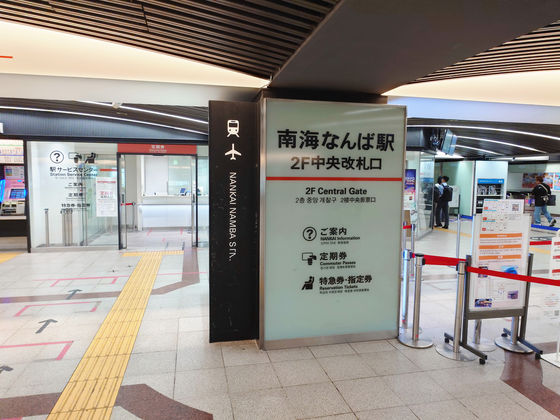
The ticket has an 'Inside Out 2' design. It costs 2,000 yen for adults and 500 yen for children.
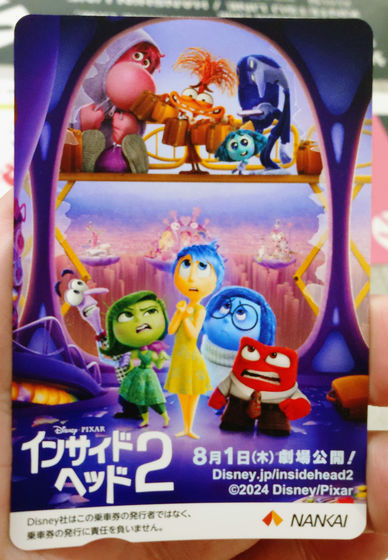
The quiz rally looks like this, with questions prepared on posters posted at all nine locations, and you can complete it by submitting it to Namba Parks Cinema at the finish line. The first one was posted at the service center. In addition, questions were prepared on the third floor of Namba Station, but there was a ticket gate next to the service center and I accidentally entered, so I decided to check it before the finish line.
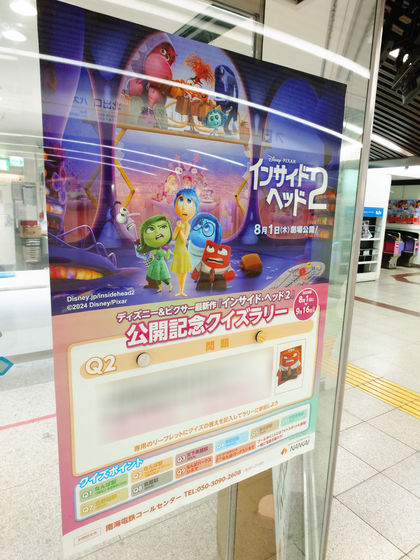
First, board the express train to Wakayama City, departing at 5:50.
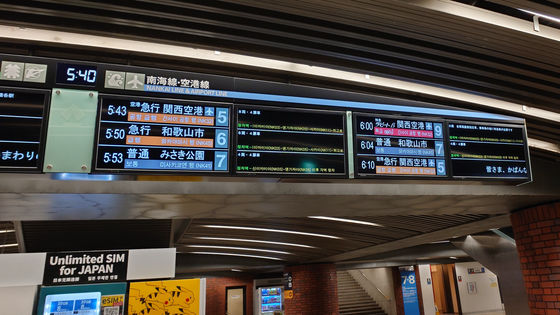
This is the first train of the day. There are many empty seats so you can travel comfortably.
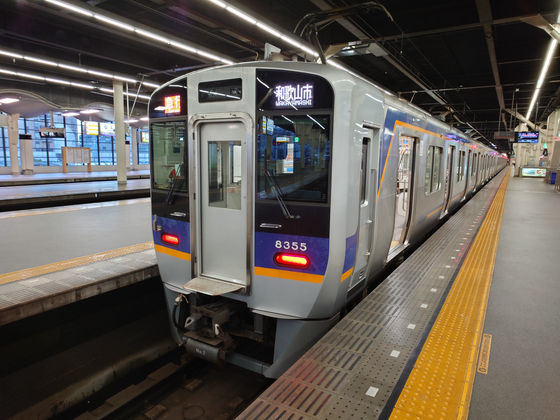
The express train headed south, slightly ahead of the local train on the Nankai Koya Line. There were a fair number of passengers at Shin-Imamiya and Tengachaya. The morning sun was shining in from the left side of the train.

An express train crossing the Otokozato River. Uto Bridge, visible in the distance at the river's mouth, is the bridge

Arrived at Misaki Park Station at 6:39.
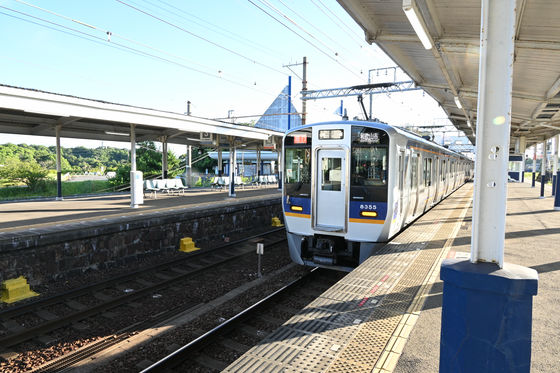
Here you change to the Tanagawa Line.
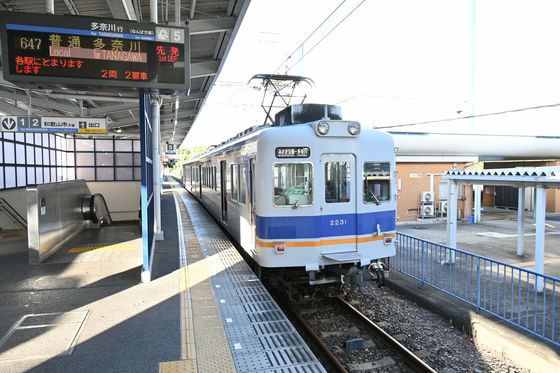
Shortly after leaving Misaki Koen Station, the Tanagawa Line turns right and separates from the Nankai Main Line.
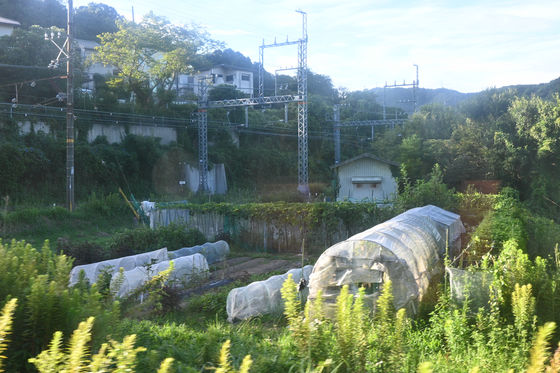
The townscape of the Fuka district spreads out on the right hand side as you travel.
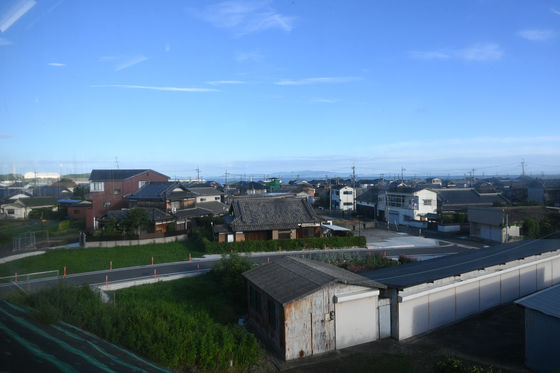
After passing Fukamachi Station, you will see the Oakwa Misaki store on your left. The bus stop in front of the store is the core of the Misaki Community Bus
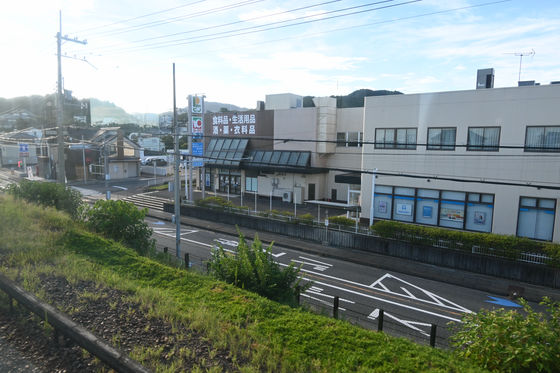
Looking back after departing from Fuka Port Station. Fuka Port is where
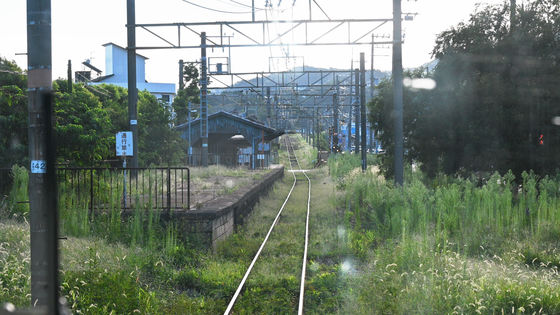
We have arrived at Tanagawa Station.
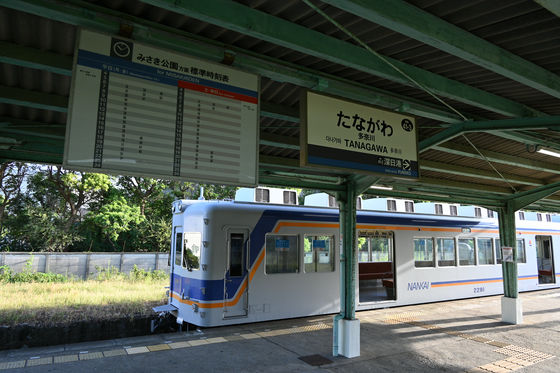
Since it was a dead end station, I got off. The fare from Nankai Namba Station was 880 yen.

After staying there for 5 minutes, we got back on the train we came on and headed back to Misaki Koen Station.
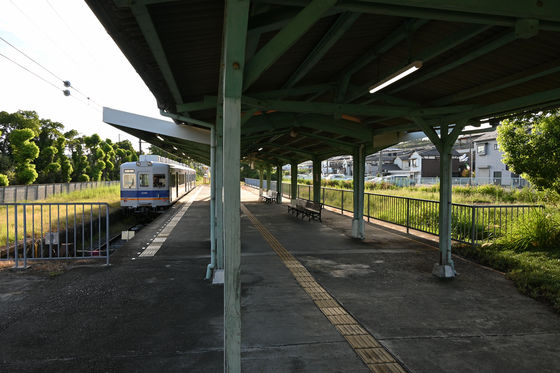
This time I finally headed for Wakayamashi Station, but I had to wait about 20 minutes to transfer. During that time, the Southern Express bound for Namba and other trains passed by.

Then we see the Tanagawa Line train depart. From this angle, we can clearly see the length of the section that runs parallel to the Nankai Main Line.
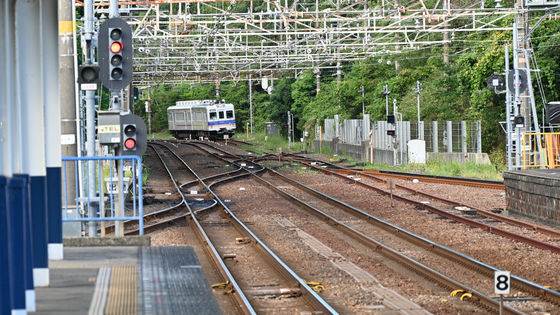
The limited express train to Wakayama City arrived, so I boarded it.
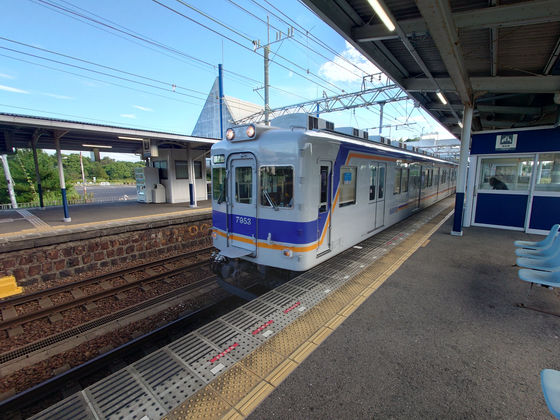
The Nankai Main Line crosses Takako Pass on the border between Osaka and Wakayama prefectures.
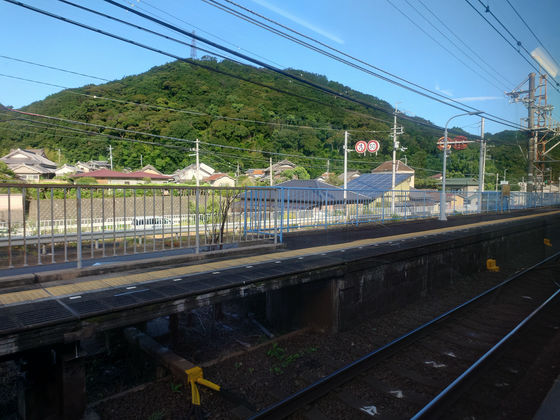
When I arrived at Wakayamashi Station, the train was stopped at the opposite platform.
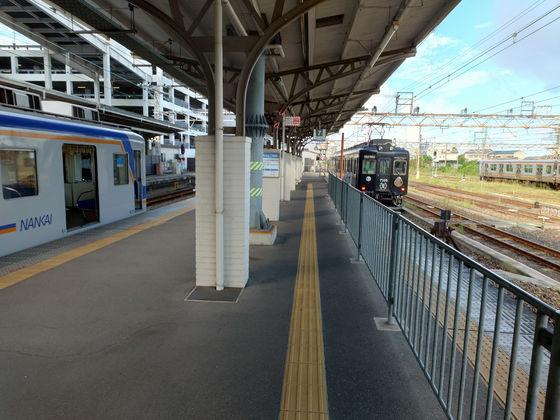
My next destination was Wakayama Port Station, so I would have been lucky to be able to catch this 'Wakayama City - Wakayama Port' train, but it seemed to be simply parked there.
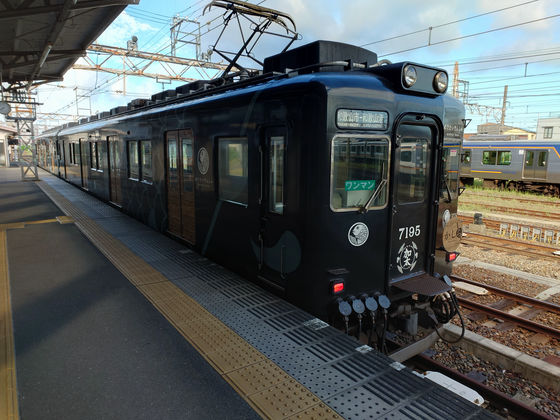
There are 11 trains a day bound for Wakayama Port, including the direct express Southern from Nankai Namba Station. There was a wait time of over 30 minutes here, but there was a 7-Eleven inside the ticket gate, so I was able to get some breakfast and eat it while waiting.
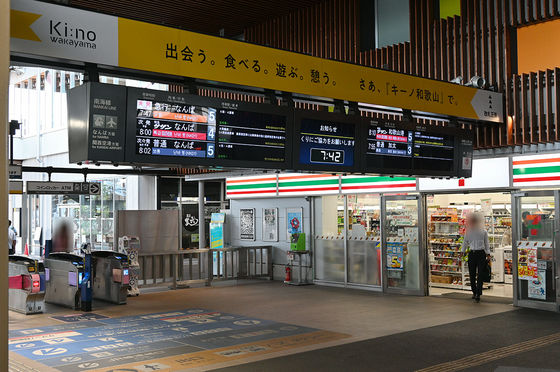
Soon, the express train Southern bound for Wakayama Port arrived. The four cars on the Wakayama Port side of the train are reserved seats and require a fee, but the four cars on the Namba side are unreserved seats and are free.
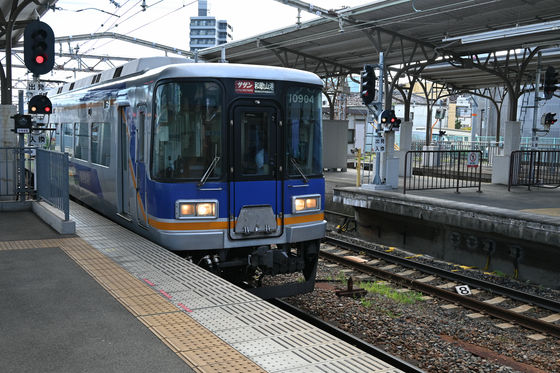
Arrived at Wakayama Port Station in 4 minutes.

When you exit the ticket gate, there is a passageway to the right.
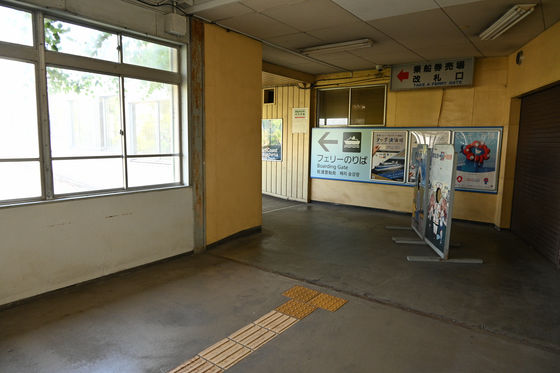
From here, you can go all the way to the Nankai Ferry terminal without going outside.
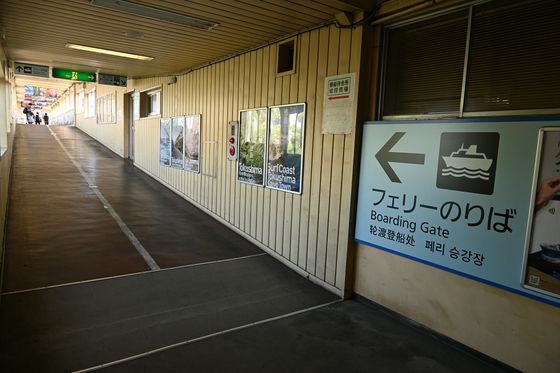
The exterior of the station looks like this. The normal fare from Tanagawa Station to Wakayama Port Station is 420 yen.
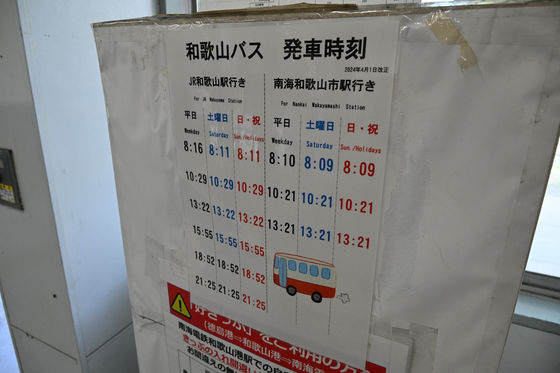
The Nankai Ferry counter is located under the connecting walkway, where people who arrive by car can purchase their tickets.
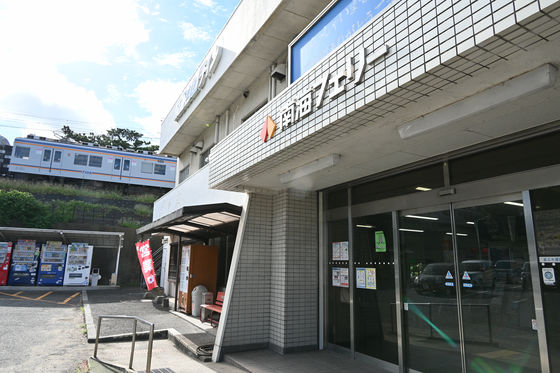
In addition, buses to JR Wakayama Station also run to coincide with the arrival of the ferry.
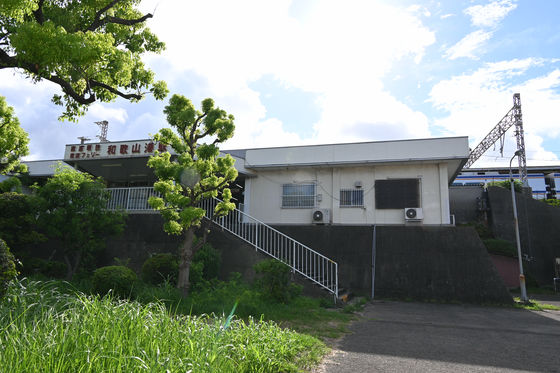
Because the timetable is based on the ferry schedule, there are no information displays, and the information for the next train looks like this, and you have to turn the page by hand.
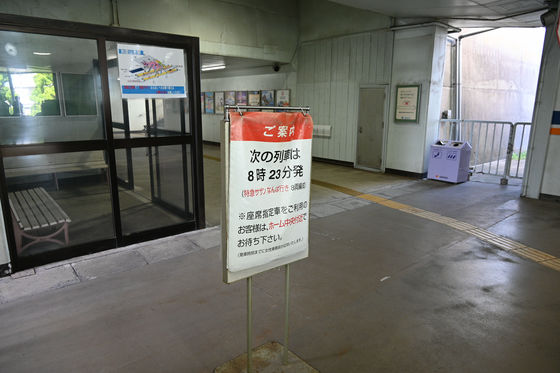
Until 2002, the Wakayamako Line extended to Mizunoki Station, one stop away. Traces of that time can still be seen.
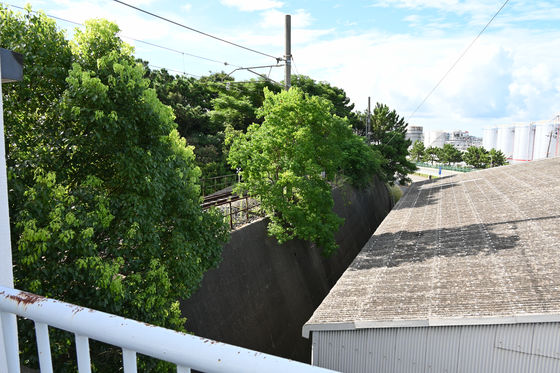
The ferry and Southern can be seen from the platform. After a 9-minute stay, we return to Wakayamashi Station.
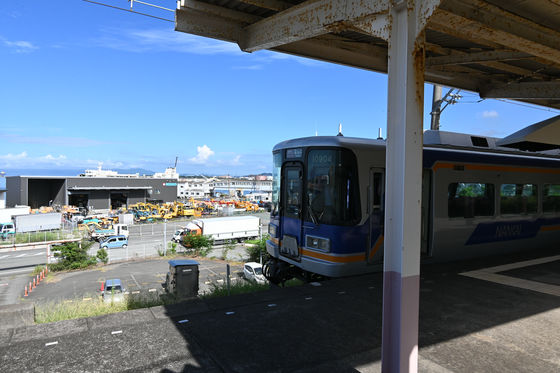
From Wakayamashi Station, we board the Kada Line, nicknamed the 'Kada Sakana Line.' The Kada Line operates several trains with original designs named '
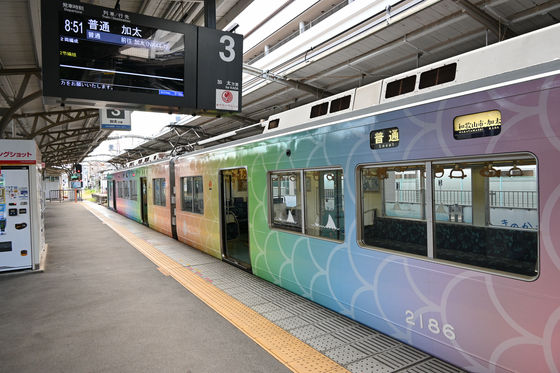
'Auspicious train' logo.
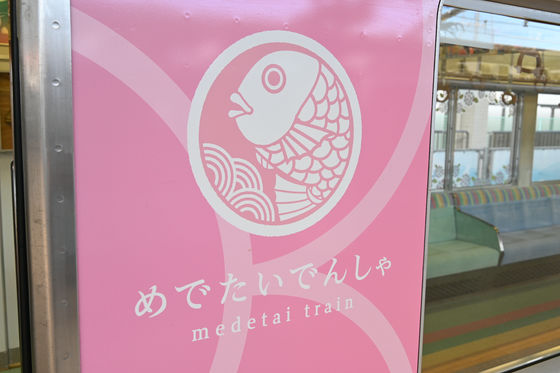
Each carriage is uniquely decorated.
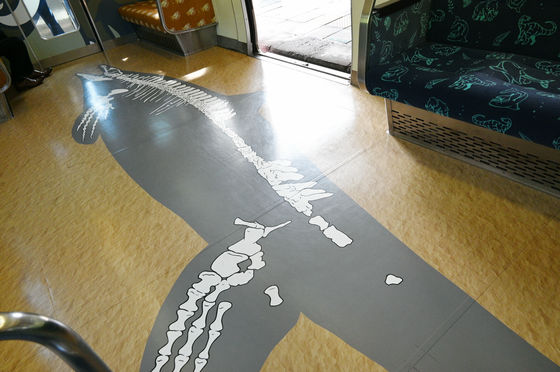
Straps designed to resemble various marine creatures.
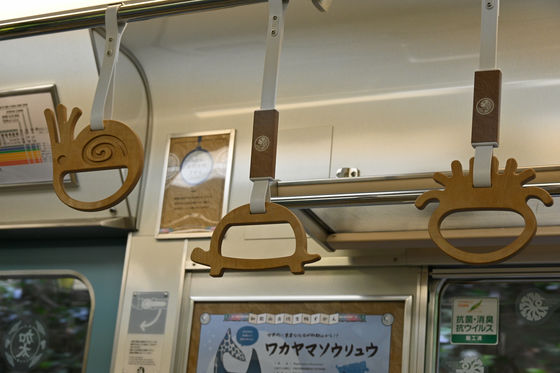
While we were waiting for the train to depart, the '
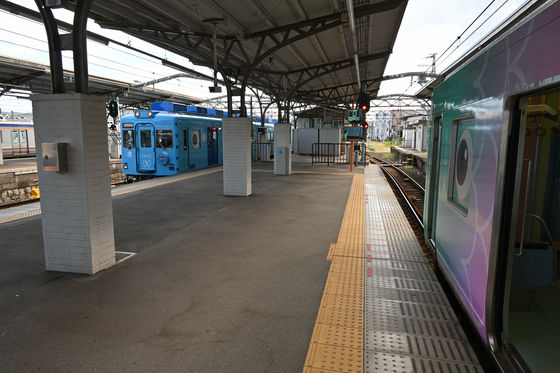
We arrived at Kada Station in 25 minutes. It seemed like there were both tourists and leisure travelers, as well as locals using the station as a means of transportation.
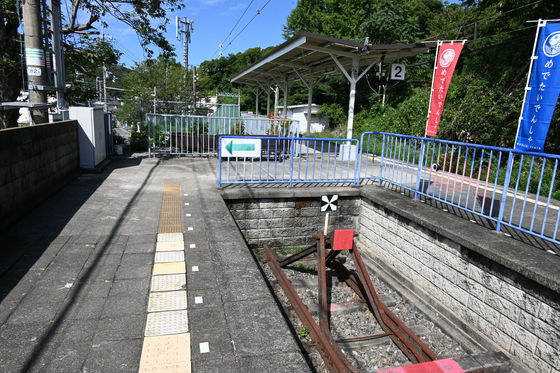
The exterior of Kada Station looks like this.
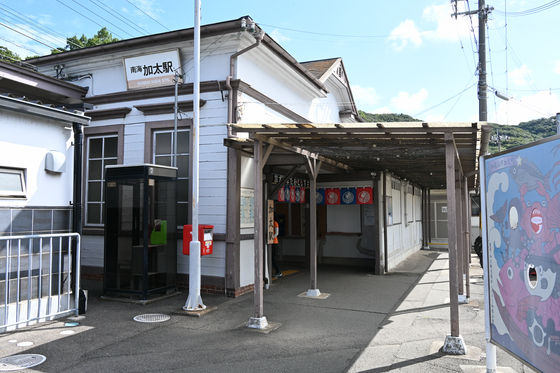
Inside the station building, there were pictures of auspicious trains drawn by local elementary school students, and a panel of Kobune Ushio from '
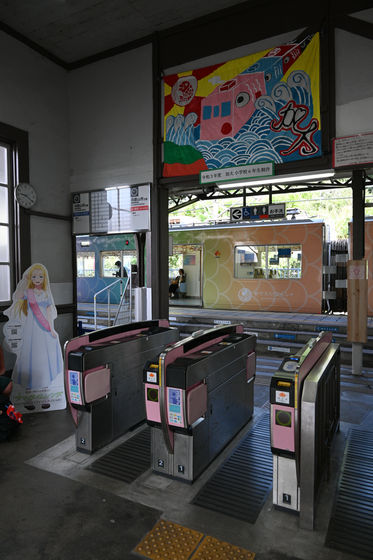
'Me' means auspicious train.
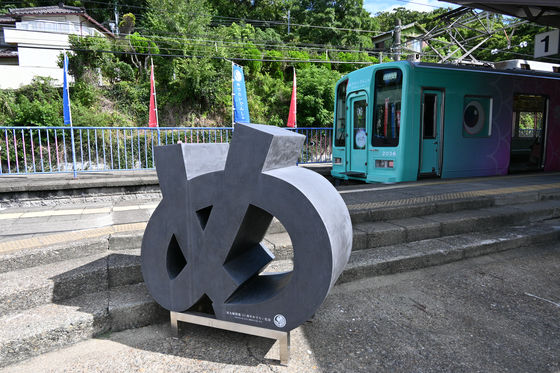

Then we head back on the train we came on.

Kada Station is a little far from the sea, but you can see the ocean from around the neighboring Isonoura Station.
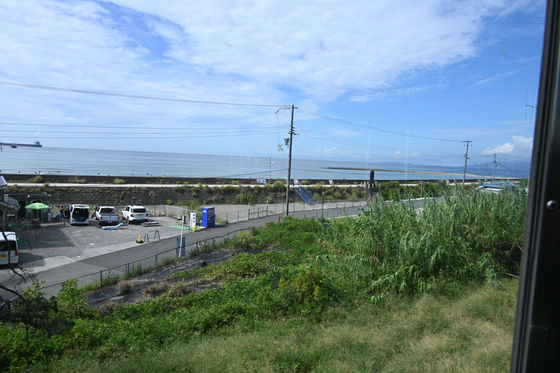
The Kada Line runs through the urban area in the western part of Wakayama City.
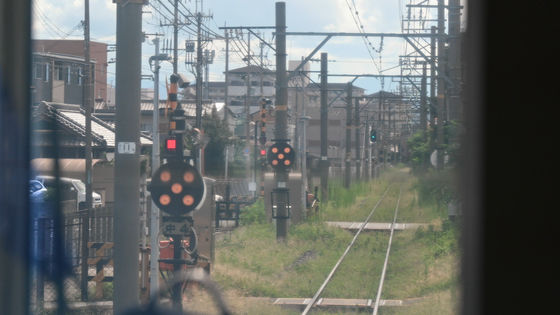
The train continues to Wakayamashi Station, but you will need to change at Kinokawa Station, one stop before.
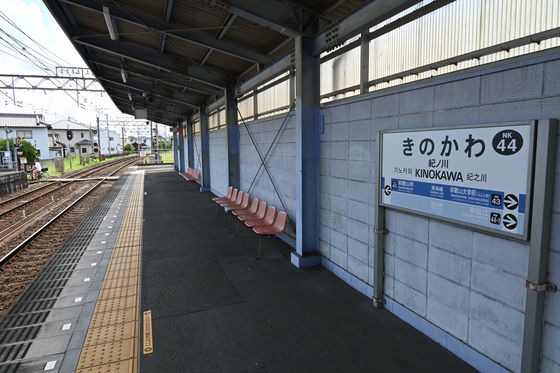
This is a local train bound for Namba, heading towards Osaka. This local train leaves Wakayamashi Station at 9:48 and arrives at Izumisano Station before the express train Southern, which leaves 12 minutes later.
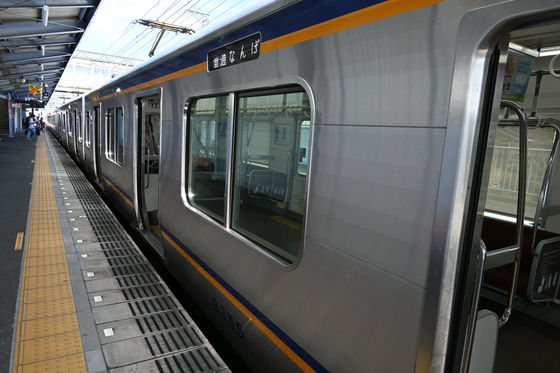
Once you pass Misaki Park Station, you will see the coastline on your left.
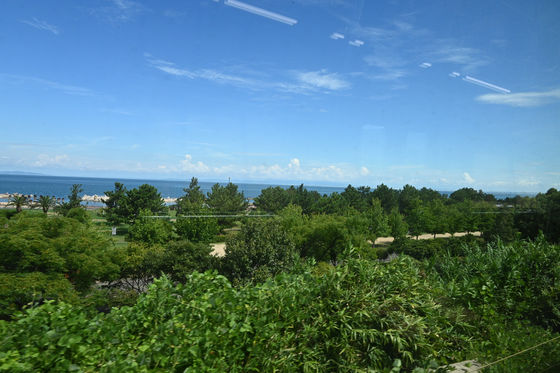
It took about 35 minutes to arrive at Izumisano Station.
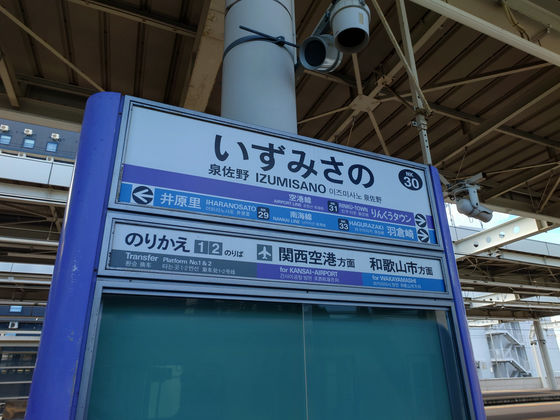
When I got off the platform at the ticket gate floor, I found a poster for the 'Inside Out 2' quiz rally behind the elevator, the first one since Namba Station. This one has questions about 'annoying.'
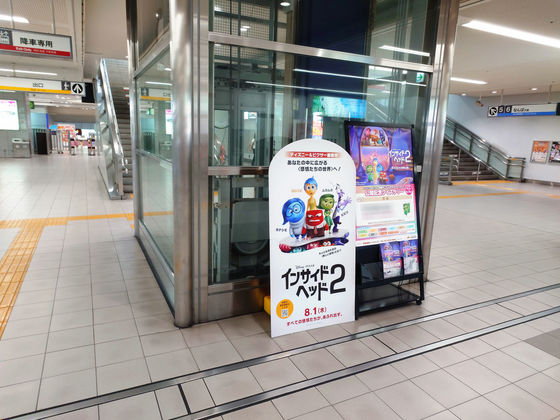
From here, I headed for Kansai Airport Station on the Airport Line. When I got to the platform, the Airport Express Rapi:t was waiting. I knew that an express ticket was required to board the Rapi:t, and that the Airport Express coming up shortly would be fine for my next transfer, so I decided not to board.
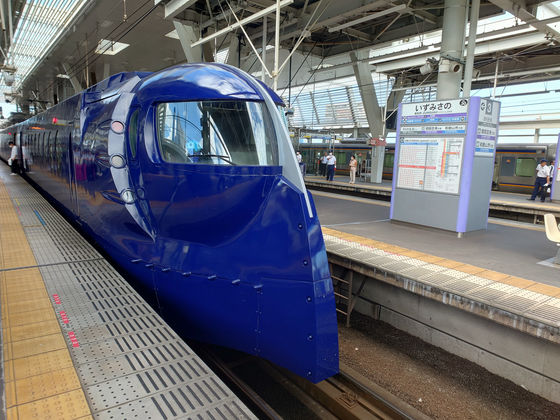
Take the Airport Express to Kansai Airport. On the left side of the train window, you can see the Nankai Main Line receding into the distance and the JR Kansai Airport Line elevated track approaching.
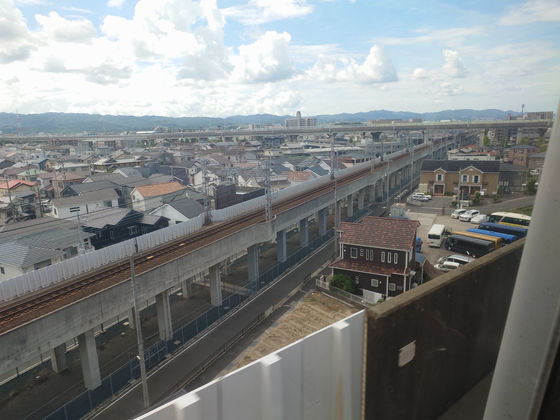
Arrived at Kansai Airport Station. Since Kansai Airport Station is one of the few stations that is not covered by the 1-Day Free Pass, you will need to pay 370 yen for the additional fare, which cannot be processed by machine and must be paid at the ticket counter. If you want to turn around, you will need to get off at Rinku-Town Station and re-enter using the 1-Day Free Pass, and if you are going further, you will need to buy a 370 yen ticket, or a ticket to your destination. This time, I am heading to Kishiwada Station, so I bought a 650 yen ticket.

'Kansai Warrior Rapi:tldier' was inside the ticket gates at Kansai Airport Station and is an image character aimed at foreign visitors to Japan. As expected, tourists were seen taking photos of him.
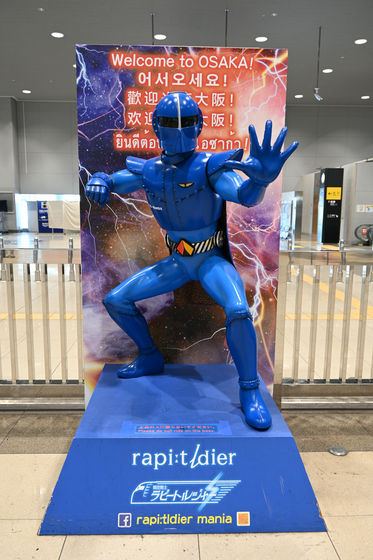
Take the Airport Express bound for Namba.
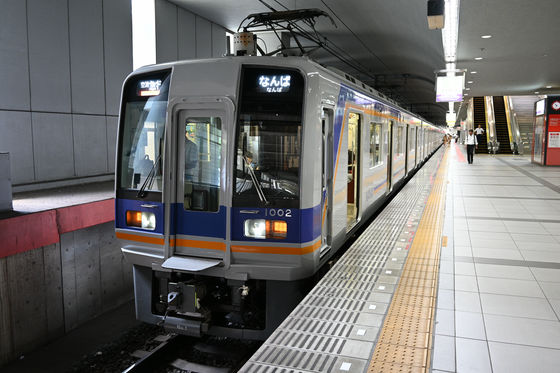
The connecting bridge is shared by both Nankai and JR, and we happened to pass a JR Kansai Airport Rapid train on the bridge.
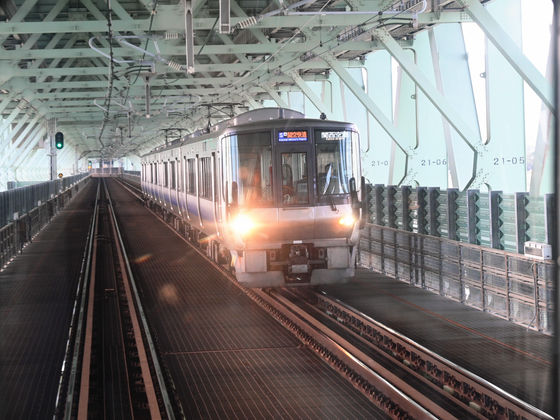
Arrived at Kishiwada Station.
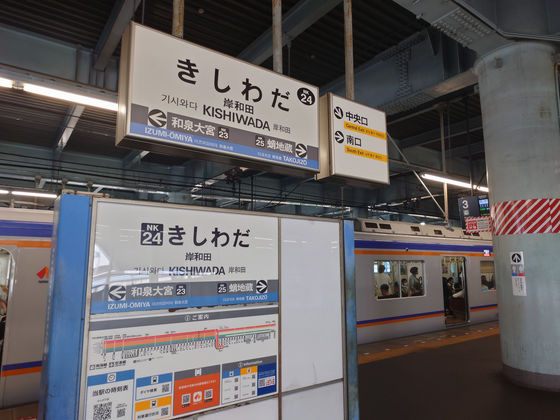
The quiz rally panel is located just outside the South Exit ticket gate.
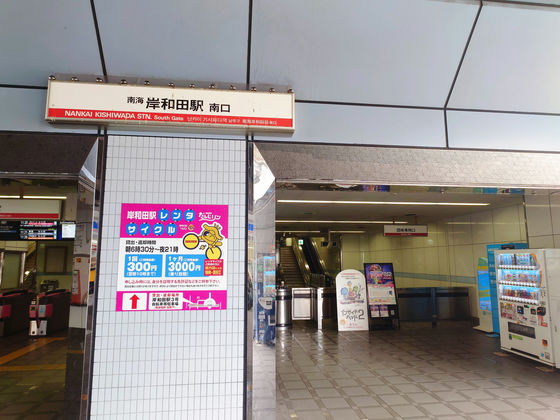
Return to the platform for trains heading to Namba and board a different Airport Express train to Namba.

Get off at Hagoromo Station.
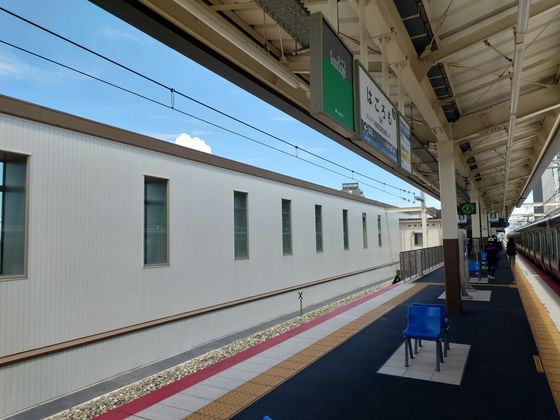
While I was waiting on the platform, an airport express bound for Kansai Airport passed by. The last four cars were painted in two shades of green, in the old Nankai specifications.
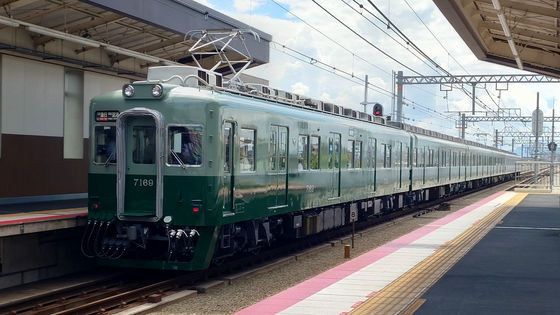
At the platform for Namba, you can transfer to the Takashimaya Line, which faces the opposite direction. In the photo, the Southern Express is passing through Hagoromo Station.
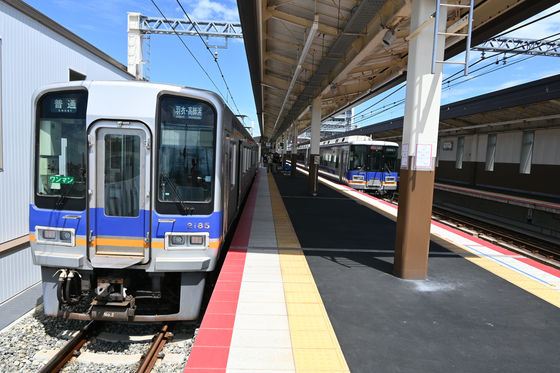
The Takashihama Line is a short line with only one station on the way, and
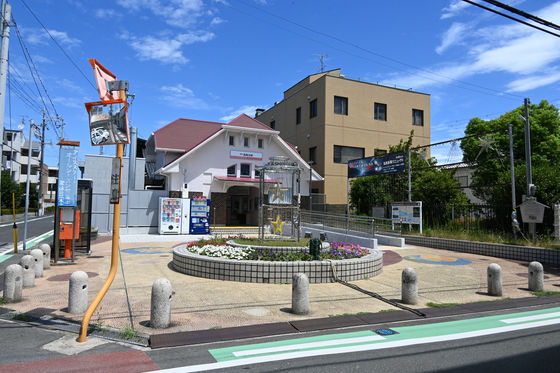
Takashihama Station has been an elevated station since ancient times.
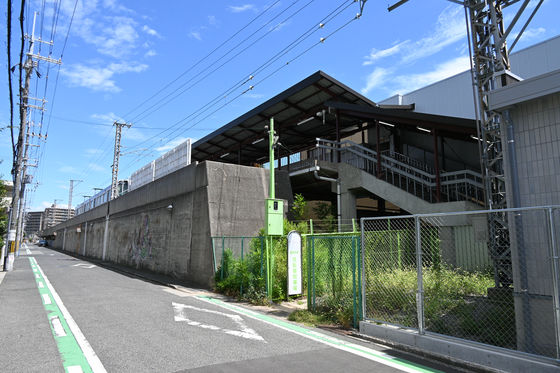
During the construction work, buses were used to replace the line. Perhaps because of this, a banner celebrating the resumption of service was hung on the wall.
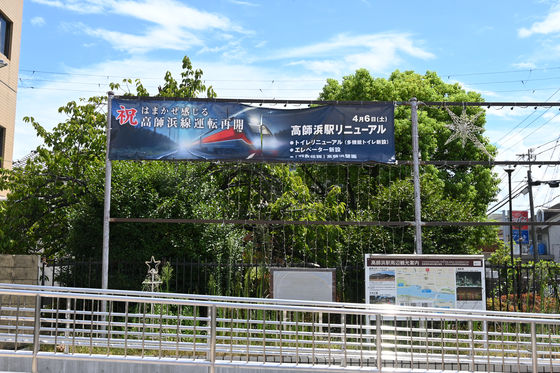
Inside the station building. The stained glass above the entrance was donated to Takaishi Station on the occasion of the 100th anniversary of the station's opening, and was replaced with a replica made of reinforced resin.

Takaishi Shrine can be seen from the platform.

The end of the line looks like this. You can see that Takashihama Station is located in the middle of a residential area lined with apartment buildings.

Visible to the west from the platform was a flare stack that appeared to belong to the Mitsui Chemicals Osaka plant.

The train has arrived so I'll turn around.

From Hagoromo Station, I boarded the Airport Express to Namba for the third time today.
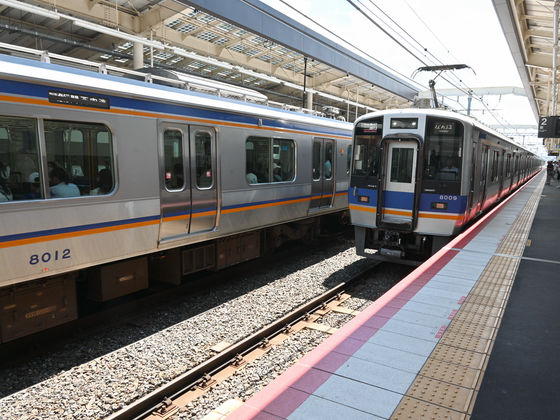
Just change trains at Sakai Station as normal.
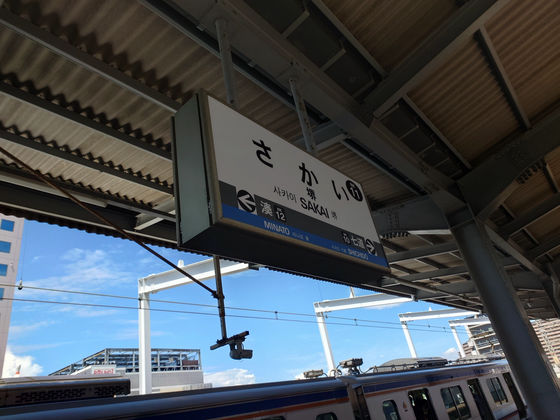
While we were waiting for the train to depart, a Rapi:t arrived.
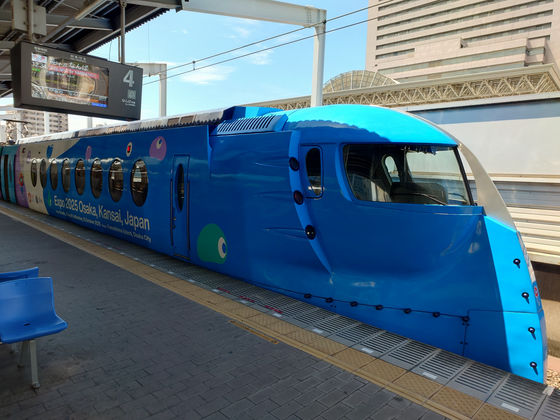
The vehicle was wrapped in the Kansai Expo theme, and had Myaku-Myaku painted all over it.

Arriving at Kishinosato Tamade Station, head towards Shiomibashi from platform 6 opposite.
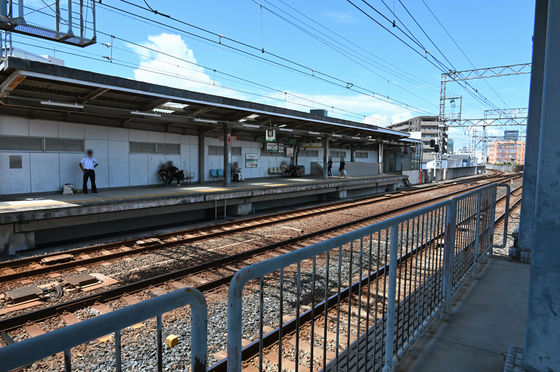
Take the local train bound for Shiomibashi.
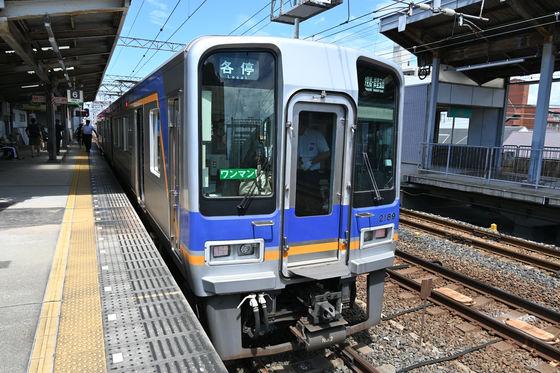
Large-scale construction work was taking place near Shiomibashi Station.
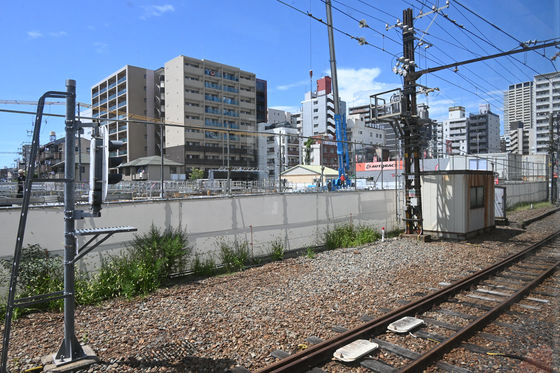
It takes 9 minutes to get to Shiomibashi Station from Kishinosato Tamade Station.
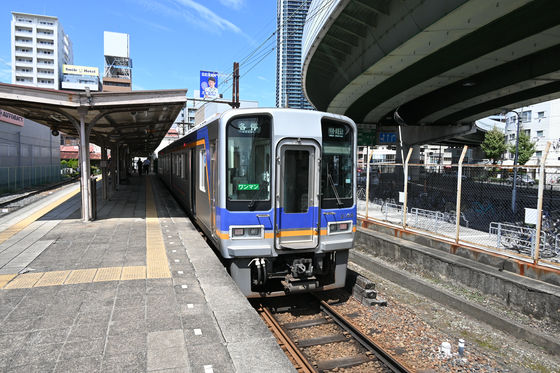
Shiomibashi Station is adjacent to Sakuragawa Station on the Hanshin Namba Line and Sakuragawa Station on the Osaka Metro Sennichimae Line.
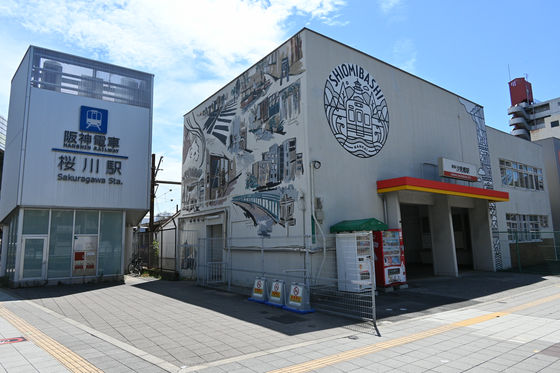
The interior of the station building is quite spacious, which is not unusual for a terminal station in the city center, but perhaps because it is only one stop away from Namba via Hanshin and the subway, it does not have many users, and trains only run every 30 minutes during the day.
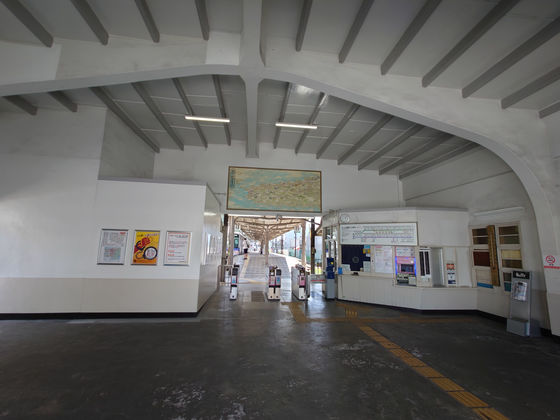
The Nankai Line Tourist Guide Map posted above the ticket gates is very interesting.

I'll return on the train I took.
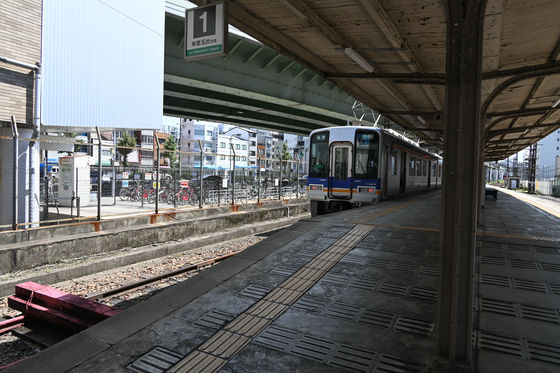
There is one train running in return, but the entire route is double track except for the area around Kishinosato Tamade Station.
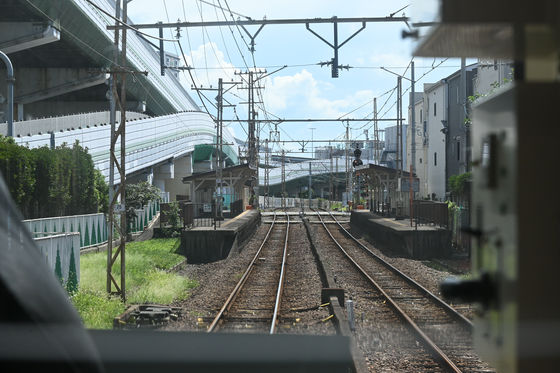
Nishi-Tengachaya Station is a very old-style wooden station.
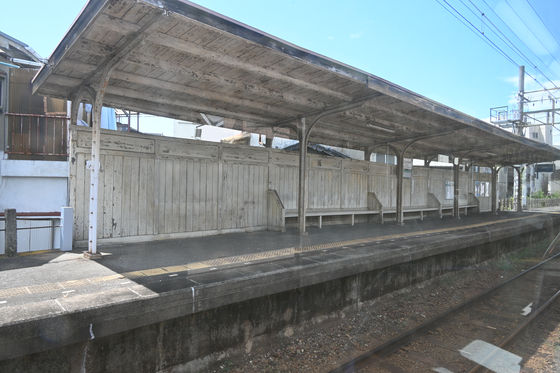
The line becomes single track just before Kishinosato Tamade Station.
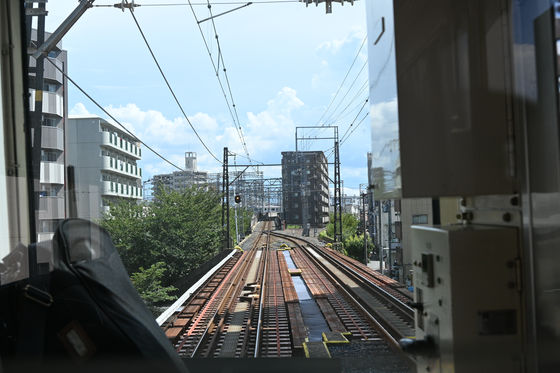
Transfer to the Koya Line at Kishinosato-Tamade Station.
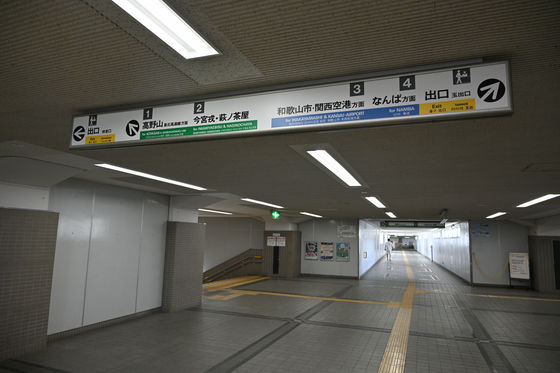
First, take the local train to Kongo to Sakai-Higashi Station.
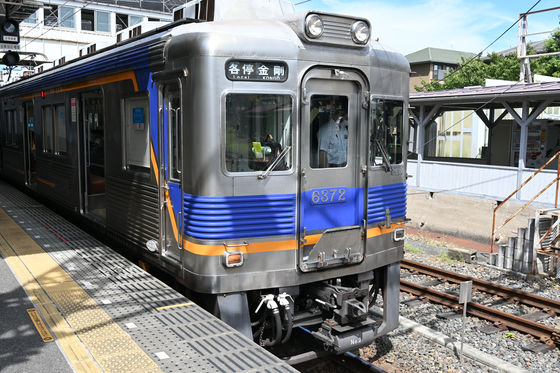
Then change to the express train bound for Hashimoto.
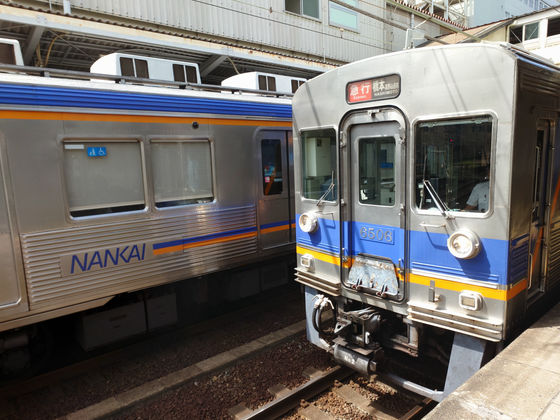
Ahead of you, on your left hand side, you will see the Great Peace Prayer Tower, also known as the 'PL Tower.'
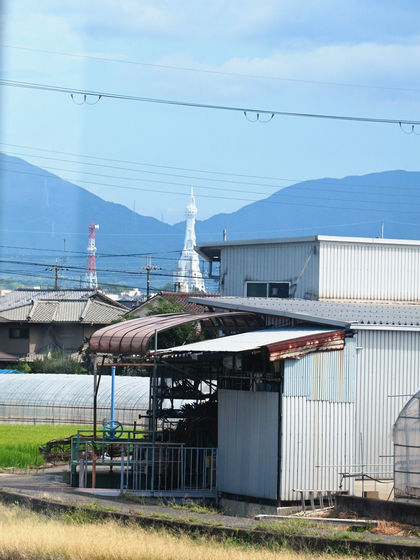
South of Kawachinagano Station, the area becomes mountainous and the number of tunnels increases.
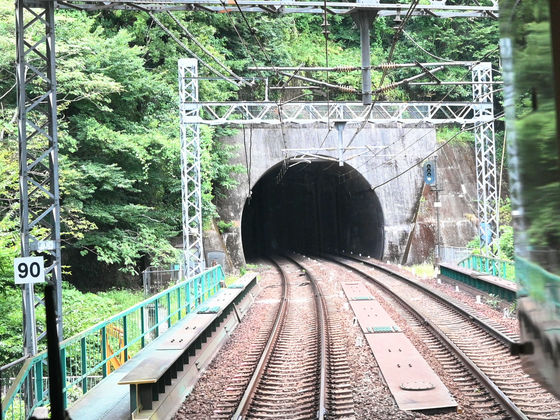
Arrive at Hashimoto Station and change to a local train bound for Gokurakubashi.
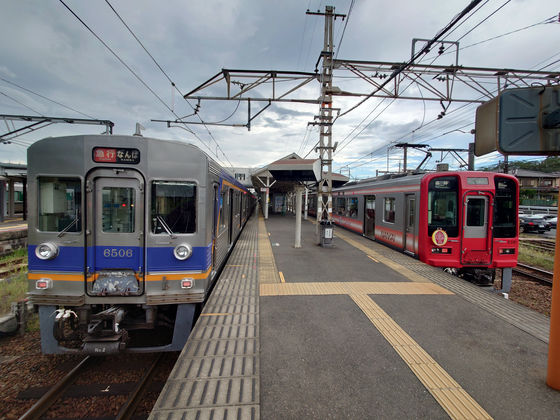
After leaving Hashimoto Station, you will cross the Kinokawa River.
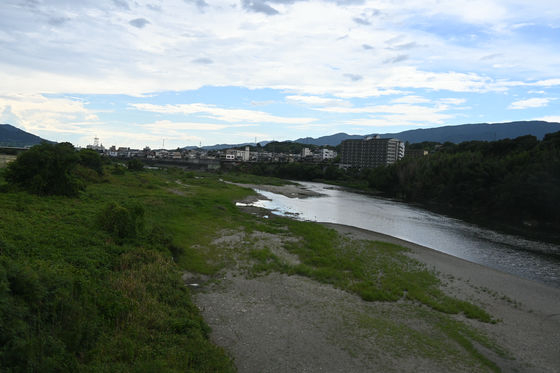
Gakubunji Station is known as a popular station for test-taking students because of its admission tickets.
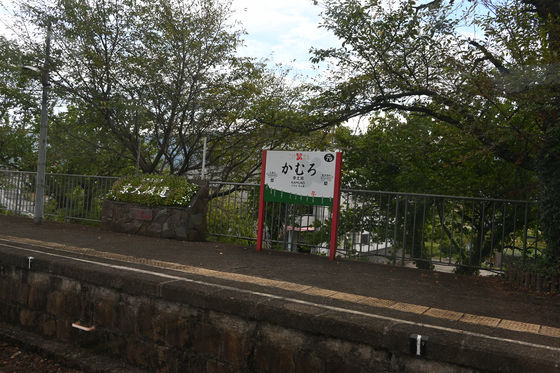
As Kudoyama Station is a place with ties to Sanada Nobushige, it has been decorated in 'Sanada style.'
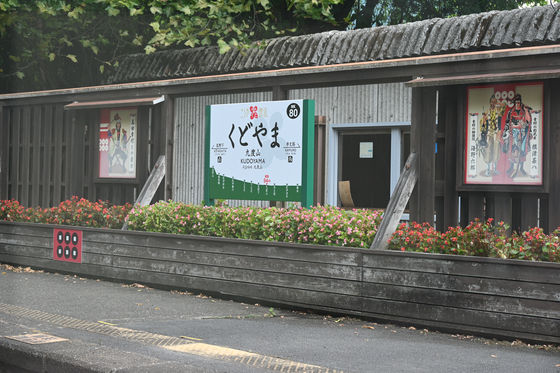
The weather is becoming quite uncertain.
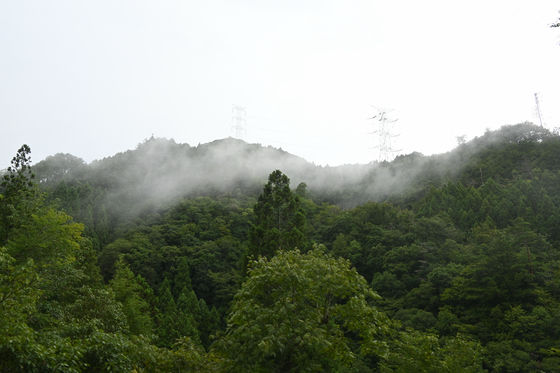
Arrived at the final stop, Gokurakubashi Station.
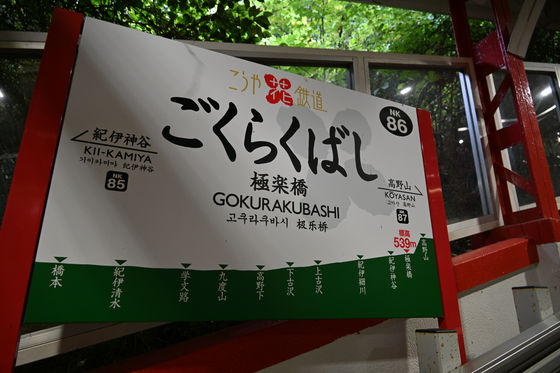
I was able to witness the scene of two trains, 'Tenkuu' and 'Koya', stopping at the station.

Although it is outside the scope of the one-day pass, we decided to climb Mt. Koya using the Koyasan cable car. The cable car costs 500 yen one way.
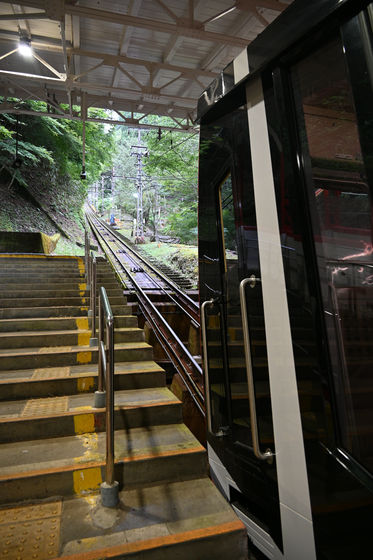
It takes about 5 minutes to arrive at Koyasan Station.
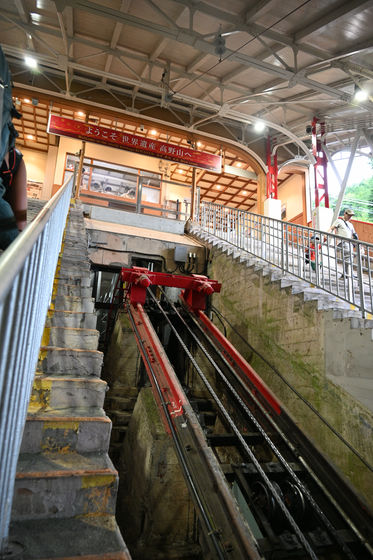
This is what Koyasan Station looks like from the outside.
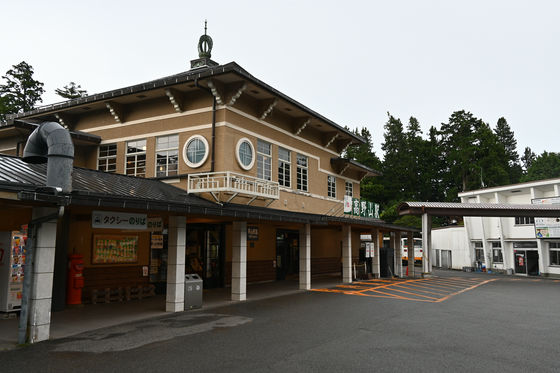
Koyasan Station is merely the entrance to Mount Koya, and you will need to travel by bus or on foot to Kongobu-ji Temple and other places. Since I am not planning on visiting temples this time, I will turn around and head back down the mountain.
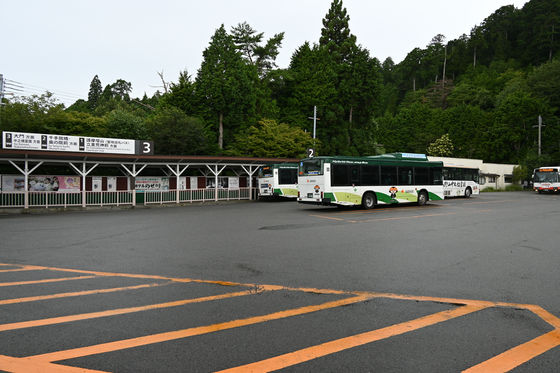
The cable car heading down passes another cable car heading up. It's starting to rain quite a bit.
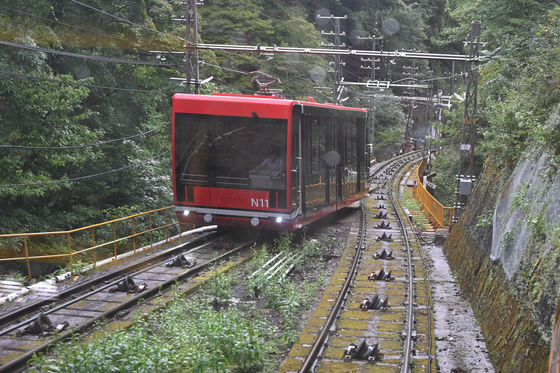
As there were concerns that the weather would worsen further, we decided to get there quickly by boarding the Koya Express, which has reserved seats.
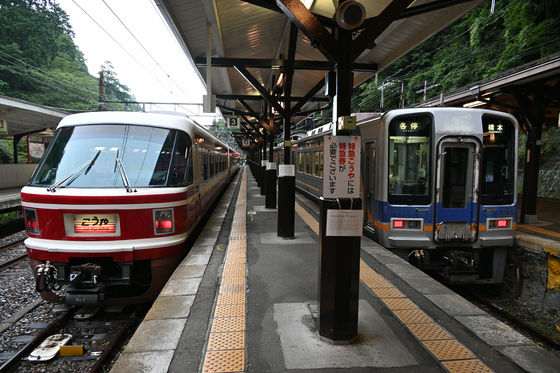
I'm going to Namba, but I'll be getting off at Kongo Station along the way.
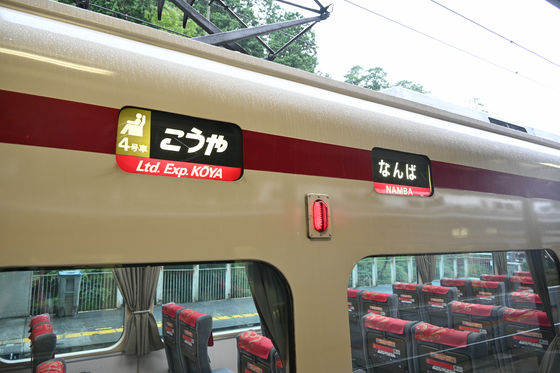
The seats look like this.
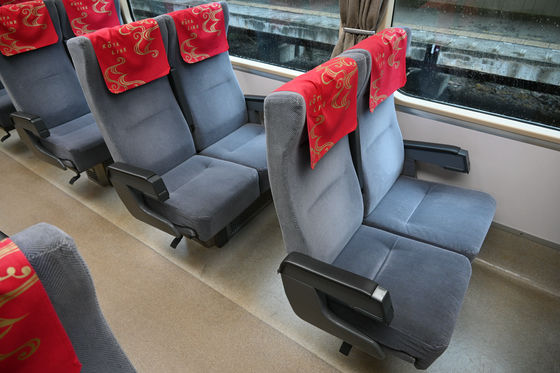
Since I was there, I decided to eat some persimmon leaf sushi and grilled rice cakes that I had bought at the convenience store at Koyasan Station.

Even though I was mostly sitting while moving around, I was still feeling quite tired, and the sourness of the vinegared rice helped.
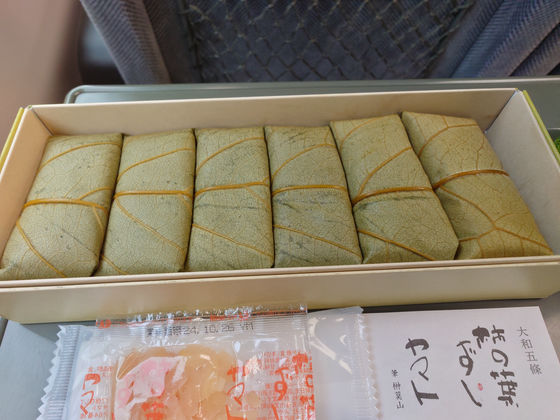
Combined with the seats being able to recline just enough, I fell asleep as soon as we left Gokurakubashi station, and before I knew it we arrived at Kongo station.
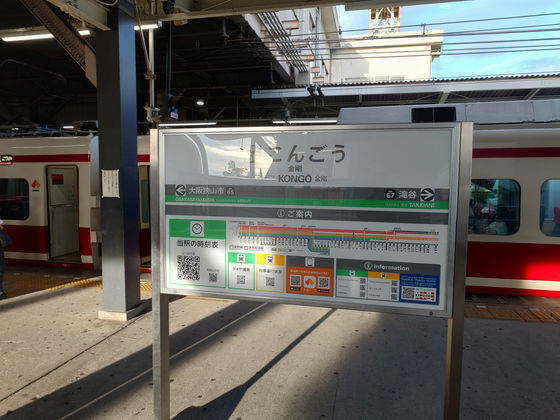
Once you go up the stairs, you will find the 'Inside Out 2' panel. The question is about 'nice'.
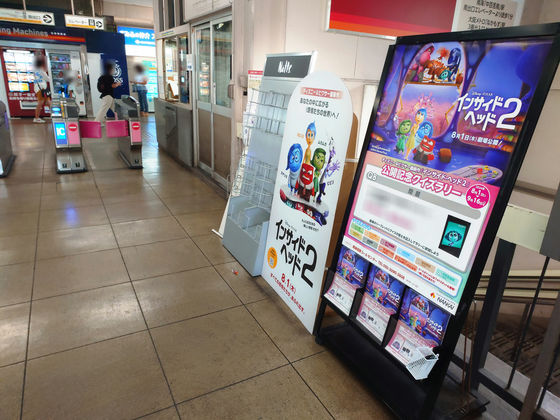
Then we moved to Kitanoda Station.
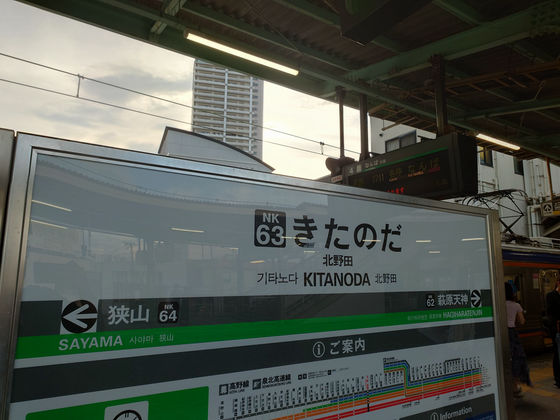
As you exit the ticket gate, there is a problem with 'Darii' on your right hand side.
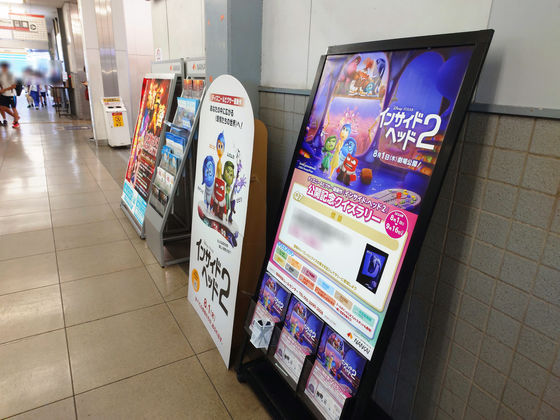
Next is Nakamozu Station. Please note that while express trains also stop at Kitanoda Station, only semi-express and local trains stop at Nakamozu Station.
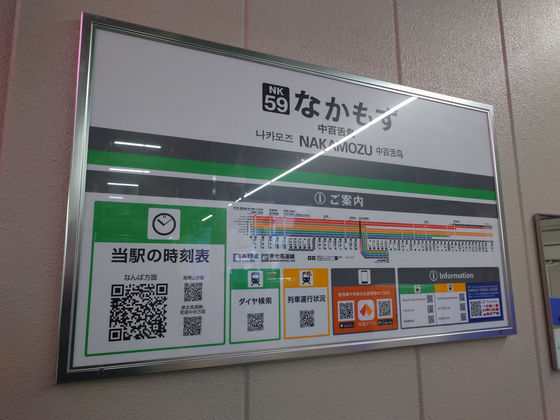
There is a problem related to 'embarrassment' on the ticket gate floor, up the stairs.
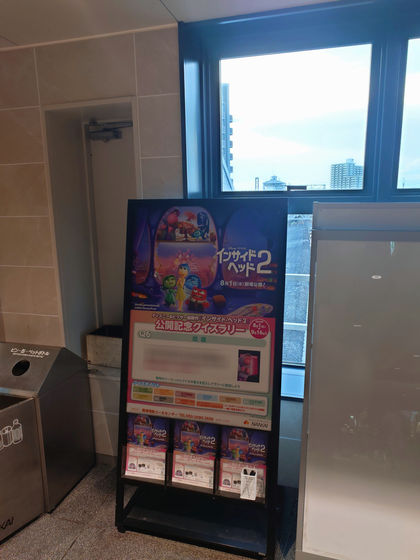
Then take the semi-express train to Tengachaya Station.
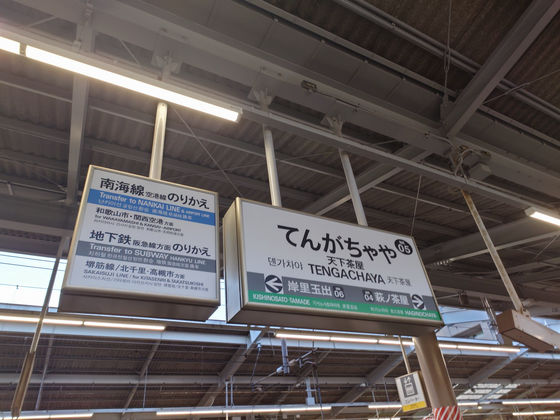
As you go down the stairs to the ticket gate, away from the usual flow of people, there is a problem with scares.
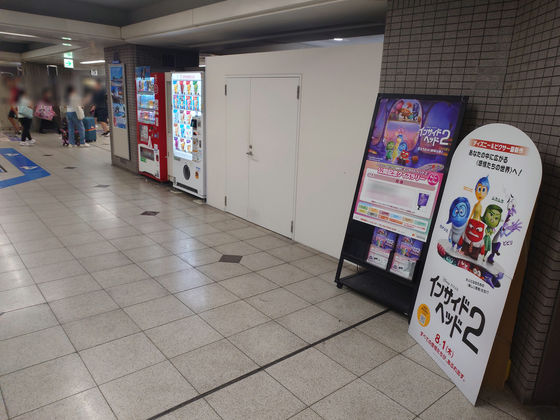
You can take any train from Tengachaya Station to Namba Station, but I took the Koya Line express train and rode every line to arrive at Namba Station.

The panel on the 3rd floor of Namba Station is located in front of the express ticket and reserved seat ticket counter.
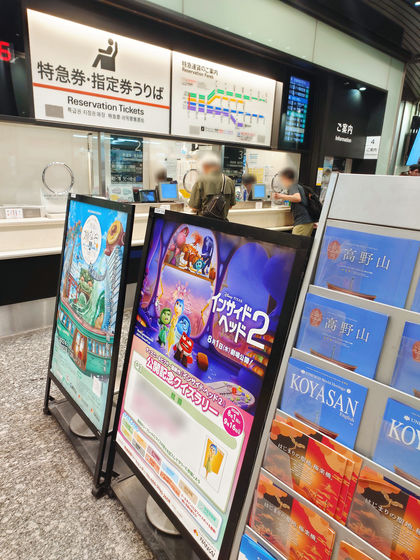
The remaining one is at Namba Parks Cinema, which is the finish point, so we go down to the second floor and head towards Namba Parks.
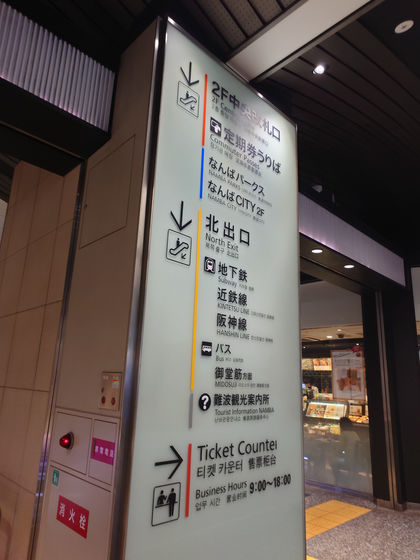
To get to Namba Parks Cinema, take the elevator at the back of Namba Parks up to the 8th floor.
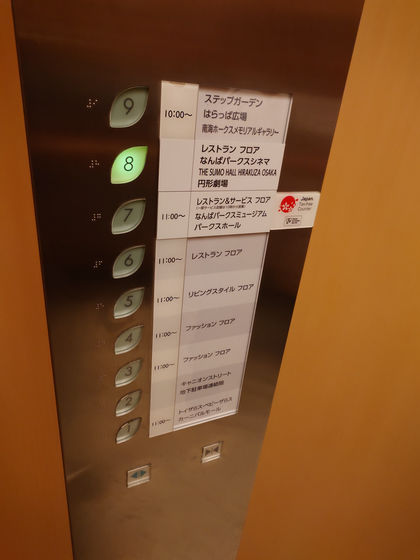
There will be a photo spot and a final quiz at Namba Parks Cinema.
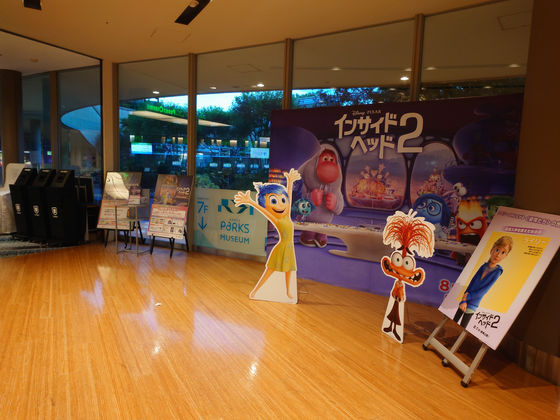
If you answer all the questions and submit them to the merchandise booth at Namba Parks Cinema, you will receive an original acrylic stand, limited to the first 2,000 people. In addition, if you purchase a one-day pass and participate in the quiz rally, you will also be entered for a chance to win original movie goods in a lottery for 10 people.
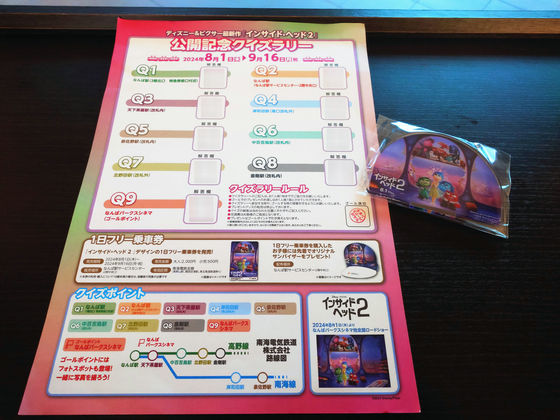
This time, I was planning to ride all the Nankai Electric Railway lines and participate in the quiz rally at the same time, so my schedule is packed, but if you only do the quiz rally, it takes 30 minutes by express train from Namba to Izumisano, and 23 minutes by express train from Namba to Kongo, so even if you travel slowly, you can get around in a few hours. On the other hand, since it is a one-day pass that allows you to ride almost all the lines, it is also a good opportunity to visit various places along the Nankai line.
·postscript
The total cost of this trip was 2,000 yen for the one-day pass + 370 yen for the Kansai Airport section + 650 yen for travel from Kansai Airport + 1,000 yen for a round trip Koyasan cable car ticket + 520 yen for a reserved seat ticket for the Koya Express, for a total of 4,540 yen.
If you do not use the one-day pass, the procedure is as follows:
Namba to Tanagawa: 880 yen
Tanagawa to Wakayama Port: 420 yen
Wakayama Port to Kada: 370 yen
Kada to Kansai Airport: 1,020 yen
Kansai Airport to Kishiwada: 650 yen
Kishiwada to Takashihama: 370 yen
Takashinohama to Shiomibashi: 420 yen
Shiomibashi to Gokurakubashi: 970 yen
Gokurakubashi to Koyasan: 1,000 yen round trip
Gokurakubashi to Kitanoda: 790 yen
Kitanoda to Namba: 420 yen
If you don't purchase a reserved seat ticket, the total cost is 7,310 yen.
Related Posts:







